Know Your Tree
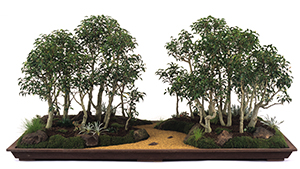
‘Little Lucy’Ficus Benjamina
by Lew Buller
Ficus benjamina comes from India and Malaysia and requires warm temperatures and regular water.
It can be grown outside year round in areas that do not experience frost, grown indoors as a house plant, or a combination of the two–outside in summer, indoors when the temperature is cooler.
A great deal of information is available on the Internet about the benjamina but very little on the dwarf cultivar “Little Lucy.‟ The material here is based solely on my experience with “Little Lucy” and will not repeat information on the Internet.When Toshio Kawamoto wrote Saikei: Living Landscapes, he said that saikei could use immature trees and that they could be repotted separately after they developed. I decided to try a large saikei with “Little Lucy” and describe the process in my book Saikei and Art, (available from BCI‟s Magazine as of this writing) Here‟s what it looked like in 2005; notice the gnarly and misshapen trees in the planting.

By 2010, the trees had grown taller; the top branches were shading the lower branches and killing them off, so I took it apart. The root mass was intermingled, but the roots could be cut with no serious side effects allowing me to plant each tree separately. The next year, I air-layered the tops–easy to do–also took cuttings and put them in a moist miniature green house, and now have 29 Little Lucys in my back yard. I knew that the full-size benjamina required a large space for roots, but was unprepared for what happened to the Lucys. In the saikei pot, soil was no more than three inches deep; the trees were crowded and couldn’t grow large roots. Giving them much more growing space was like undoing one‟s belt after a tremendous Thanksgiving dinner: things just burst loose.Look carefully at the next photo showing the back of the tree. At the base of the pot you will see a few small roots protruding-—remember them. In addition to the obvious split in the one-gallon pot, the branch from the left hand tree crosses over in front of the right hand tree. (There is also a scar on the back of the left hand tree–a photo appears later.) The fact that the benjamina is in the rubber tree family has a bearing on both. In general, members of the rubber tree family exude latex when cut. When branches are cut, they exude latex quickly to seal the cut. Roots and leaves also do this. 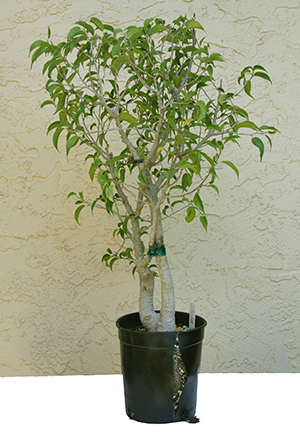
In a healthy tree, latex moves so quickly that it makes side-grafting very difficult. The cut fills up, begins to seal the cut, and does this before the scion can be introduced. Approach grafting works, but it is very slow and leaves a large lump. That‟s why the approach graft shown here is on the back of the tree–so the lump won‟t be readily visible. I haven‟t tried thread-grafting yet, but will do so as I have plenty of trees to experiment with.
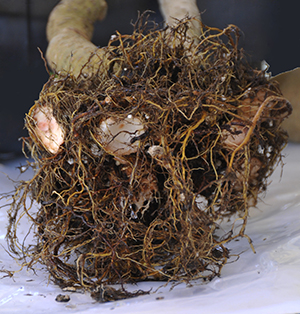
Did someone say “Cut roots?” The roots after cutting are in the same relative position as in the photo above, i.e., the crooked tree is on the left. The cut root second from left is about the same size in diameter as the trunk of the curved tree. The small yellow roots are a healthy color. Black roots would indicate root rot and thread-like white roots are weed roots.What I want for this tree is a wide but shallow pot, with room for vertical as well as horizontal root growth. Two pots used together will make this possible.I learned this trick from Mrs. Sarver, who ran an azalea nursery in San Diego. Azaleas are well known to require acidic soil, down to a pH of 4, available in straight peat moss. The soil in San Diego is highly alkaline. She sold her clients azaleas that had broad but not deep root bases with instructions to transplant every three years and replace the peat moss that kept the saline soil at bay.
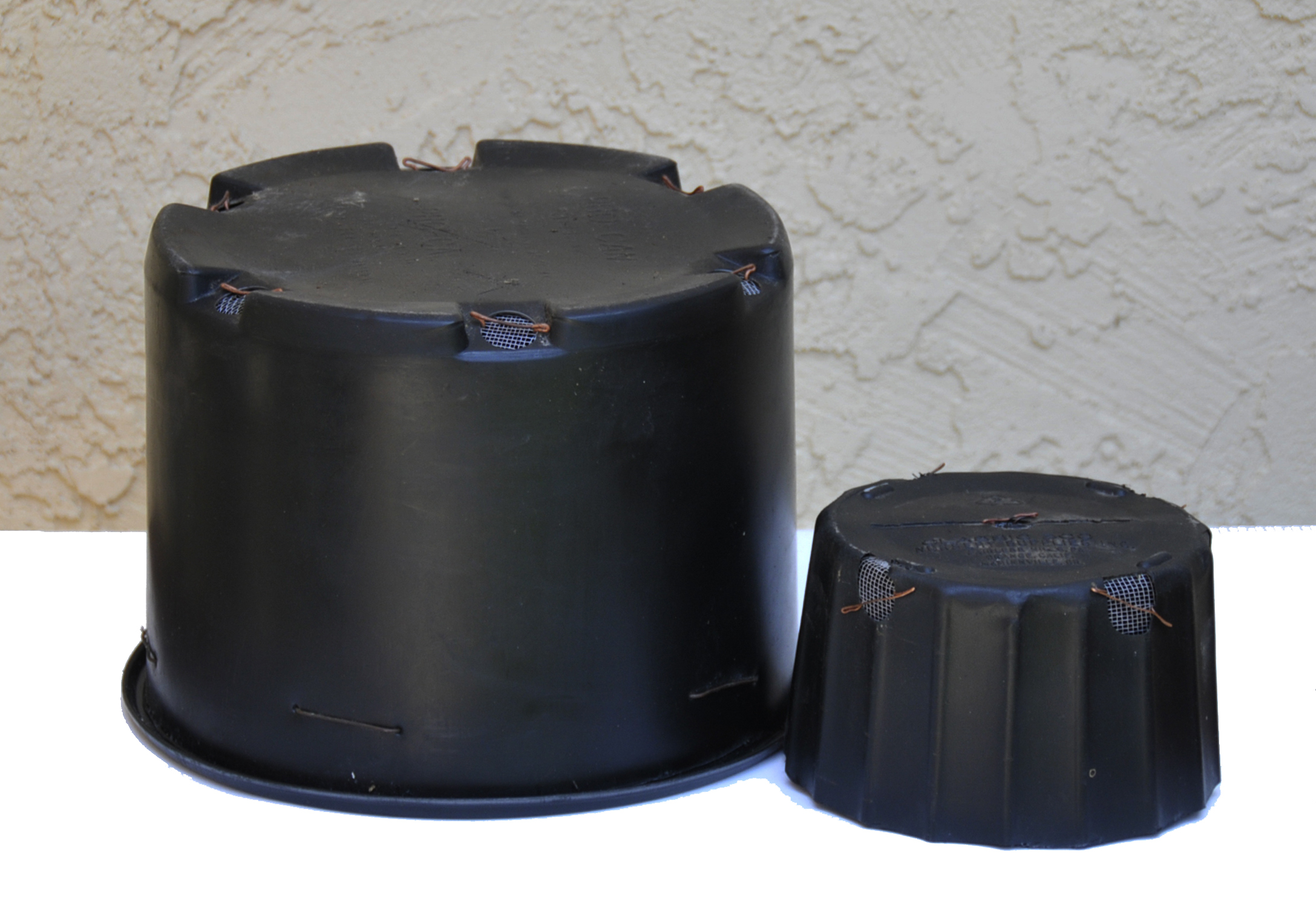
A photo combining the two pots gives a good idea how this will work. Soil is added to the top of the center pot and more around the edges. The root mass is placed on the center pot, adjusted to give more or less growing space on each side of the trunks, and then soil is worked in around the remaining roots. The finished product appears last.
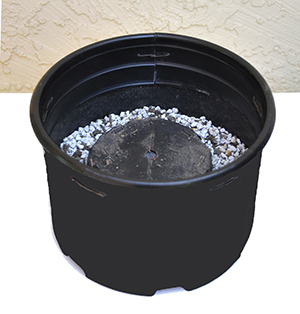
Now it's time to talk about scars and their healing. The scar to be healed is on the right hand tree, just below the branch that is being used for approach grafting. The latex dried and regularly I will use a knife or other sharp-edged tool to irritate the cambium. This stimulates the cambium to grow, to grow more than the amount removed by scraping the cambium.

Here‟s a close-up of an old scar at the base of the right hand tree: The light gray color gives away the old scar; with a few more scrapings, it will be the same as the rest of the bark. Also, the old scar does not yet have the same horizontal markings as the tree above and below the scar. Don’t try that with your junipers; they have a very thin bark and do not callous over well. The ficus is the only tree I know that will respond this way.
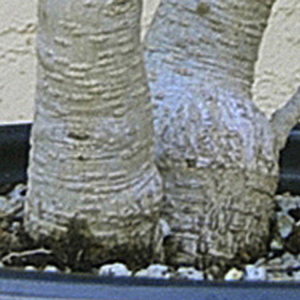
The same root trimming is applied to my ficus retusa (ficus microcarpa). It is not a miniature. The largest Lucy I have is two inches at the base of the tree, estimated at 20-25 years old. The retusa was imported from Taiwan, was 10-15 years old when I bought it, and I have had it for about 15 years, making it 25-30 years old. The widest part of the trunk is six and one half inches across. It is 22 inches tall and 28 inches wide. This is a tree that could grow to be 30 feet tall in the ground.Because the leaves are larger than those of the Lucy, I sometimes cut them to maintain an even silhouette. Latex seals them and they continue to function as leaves. 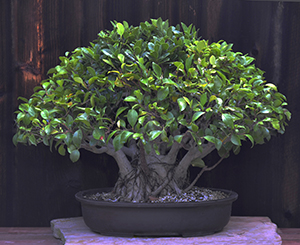
It is too heavy for me to lift. My apprentice, Eitan, helped me transplant it in April 2014.
